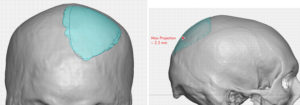Background: Aesthetic skull deformities occur in a very wide degree of severities and presentations. While many think that such skull shape issues are probably large and obvious, I have found that some are quite small and often obscure to the casual observer. But to the patient smaller skull defects can be just as disturbing as those that can be clearly seen.
One of the common areas of the skull that is often bothersome is the back of the head. While complaints may be of its size, too big or too flat, there are an equal number that relate to its symmetry. One side of the back of the head being flatter than other, often referred to as plagiocephaly, is a condition that I commonly treat. Whether the patient can see it because they have a shaved head or closely cropped hair or whether they can simply feel it through good hair cover, I have seen patients opt for treatment in either an exposed or camouflaged skull shape.
It is not clear why a skull area that is the hardest for some patients to see can be a source of aesthetic anxiety, but it can be. Since custom implants is now the standard way to treat any broad-surfaced area skull deformities, it becomes possible to effectively treat even the smallest of such skull shape deformations.
Case Study: This 57 year-old male had been bothered for a long time by the shape of the back of his head. There was a dip on the upper right occipital skull and a modest protrusion on the left side. Using a 3D CT skull scan, a small right occipital skull implant was designed to precisely fill the bone dip.

Small skull contour defects can often be the hardest to improve without creating other aesthetic issues. As a general rule the smaller the defect the more precise the contour restoration must be. Anything short of near perfection can just be another aesthetic concern. Custom designing the implant creates the best chance of minimizing these potential iatrogenic aesthetic concerns.
Highlights:
- Custom skull implants can be made for smaller select skull defects.
- One of the most common aesthetic skull deformities is that of plagiocephaly where the back of the head is asymmetric.
- Custom occipital skull implants are usually placed through a low horizontal hairline incision on the back of the head.
Dr. Barry Eppley
Indianapolis, Indiana




